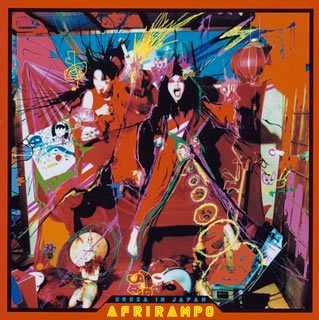I must confess that ever since I discovered Ruins, I have been stalking throughout the internet the band's drummer and currently single member Tatsuya Yoshida. The best of it was that the more I discovered, the more there was to discover. But finding something about Yoshida's other project, Koenji Hyakkei, was a little hard at first, and an endeavour that I thought to be jinxed. Everytime I found a link, it was either broken, down, not working properly and god knows what else. But finally, after much rummaging through the middle pages of google searches, I came up with their latest album, Angherr Shisspa. I finally got lucky. But, to be honest, I didn't like the sound at first. Although I was already used to different music, chaotic melodies or even the lack of such, I wasn't prepared to such a heavy use of singing, at least without more Kobaian in the middle.
But, goddammit, I didn't come so hardly to find the album just to dismiss it. So I gave it another try. And another. And Yet another, until I found myself whistling the tunes on the street. Of course, after this, I haven't managed to put it down. It's not just good, it has the weird zeuhl vibe, delves a bit into lyrical singing, and comes up with stunning songs that just want to go on and on. The voice becomes truly an instrument in this album, and doesn't just ride the wave the other instruments create.
Enjoy the album, and if you don't like it at first, give it another try. And another. And yet another.
Here's a better review from
Prog Archives:
After a 4 year break, Yoshida Tatsuya's Koenjihyakkei (the Japanese Magma) return with an excellent new album, a new line up and a different sound. Bassist Sakamoto Kengo remains, but the female front line is all new. Yamamoto Kyoko is the main vocalist and sounds like an operatically trained soprano. Kanazawa Miyako plays keyboards, and where her predecessor used mainly 70s sounding electric keyboards, she concentrates mostly on piano with a few synth flourishes here and there. Komori Keiko plays soprano sax and clarinet, and possibly also also some other reed instruments. Underpinning it all is the relentless, virtuosic drumming of Yoshida Tatsuya, who is still the main composer. All members of the band sing, which allows for some stunning vocal arrangements. Where the sound of Nivrayam called the later Magma of Udu Wudu and Attahk to mind, Angherr Shisspa recalls the instrumental backing of 1001Degrees Centigrade (particularly the interplay between piano and reeds) and the massed vocals of Mekanik Destruktiw Kommandoh.
The album opens withTziidall Raszhisst, the celestial soprano of Kyoko floating over a delicate piano/synth backing before the rhythm section crash in and voice and soprano sax chase each other over an impossibly tight piano/bass/drums backing, interspersed with the occasional chorale. Kengo's bass takes the lead during a brief Ruins style interlude before the band return to the main theme and the album is still less than 4 minutes into its playing time. This pretty much sets the scene for what is to follow - pieces in complex time signatures which change every 12 - 16 bars, the whole thing played with near mathematical precision but also with great feeling.
Rattims Friezz, the album's second track, was composed by Kengo but complements Yoshida's compositional style beautifully. If anything there is a more overt jazz influence here, but it's very much in keeping with the album as a whole.
Grahbem Jorgazz is a contribution from keyboard player Miyako, and moves more towards the austere modernism of Art Zoyd or Henry Cow and which pushes Kyoko's voice towards the to of its range.
The real gem on the album is Fettim Paillu, the fourth track. It opens with a lengthy (by Yoshida's standards) voice/piano duet which shows just how much he has matured as a composer. The entry of bass, drums and sax pushes us back into familiar Zeuhl territory, especially when Yoshida delivers a Christian Vander style lead vocal which is a highly effective contrast to the soaring soprano, while the arrangement recalls some of Shub Niggurath's wilder moments. About half way through there is a beautiful piano/clarinet interlude which veers between jazz and contemporary classicism. A brief reprise of the opening piano/vocal interlude follows, before the manic frenzy makes a brief return. This could be Yoshida's finest composition to date.
Qivem Vrasstor opens with a highly effective call and response of the main theme, with female voice and soprano sax being echoed by male voice, bass and drums. The relative simplicity and clarity of this track is on a par with Christian Vander's Wurdah Itah, although the arrangement is slightly more fleshed out.
The only below par track is Mbingvahre, another contribution from Kengo which starts out with some massed chanting and rudimentary percussion before veering off in to an Acid Mother's Temple style freak out. As a stand alone track it's highly effective, but it disrupts the flow of an otherwise seamlessly sequenced album.
The title track is a return to the style of the earlier pieces, with Keiko switching to what sounds like tenor sax to produce some Coltrane like squalls, and with Miyako adding rather more synth to the sound. This track contains perhaps the best sax/vocal interplay on the album, punctuated with Yoshida's ride cymbal. There's also a nicely judged jazzy interlude which is allowed to run its course and showcases Kengo's bass playing.
Wammilica Iffirom closes the album, and by this stage there are no more surprises in store. Keiko uses an echo unit to build up a more meaty sax sound, and each band member gets a turn in the spotlight. The tempo slows down dramatically towards the end, and the band play what sounds suspiciously like Kreuhn Kohrmann Iss De Hundin (the end of Magma's MDK) before returning to the main theme.
This album falls just short of being a masterpiece - the inclusion of Mbinvahre causes the album to lose direction, but otherwise it's a near flawless piece of work. There are a few nods towards Magma, but as ever Koenjihyakkei have their own take on Zeuhl. This album also sees a maturing of their musical style - while there are plenty of sudden twists and turns, they're also prepared to let the quieter, more melodic interludes unfold and develop at their own pace. 4.5 stars - if you're only going to buy one Japanese Zeuhl album, this is the one to get. Koenji Hyakkei - Angherr Shisspa (2005) - Skin Graft Records Download
Download







